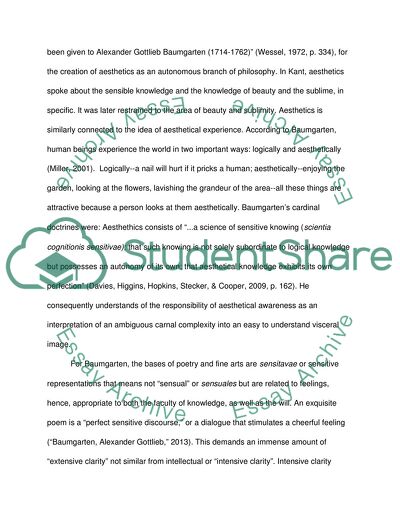
- Home
- Free Samples
- Premium Essays
- Editing Services
- Extra Tools
- Essay Writing Help
- About Us
- Studentshare
- Subjects
- Miscellaneous
- Critically assess the thoughts on aesthetics of one Alexander Baumgarten
Critically assess the thoughts on aesthetics of one Alexander Baumgarten - Essay Example

- Subject: Miscellaneous
- Type: Essay
- Level: Undergraduate
- Pages: 4 (1000 words)
- Downloads: 0
- Author: willtheresa
Extract of sample "Critically assess the thoughts on aesthetics of one Alexander Baumgarten"
Aesthetics perhaps is defined as the study of beauty or collectively will be called the philosophy of art. In the 18th century, the customary attraction for beauty widened that they include abstract art. Hence, this paper will assess the thoughts and theories on aesthetics of Alexander Baumgarten. Aesthetics was believed as the study of the beautiful (Wessel, 1972). It is also concerned with matters that surround creation, its interpretation, and the absolute acknowledgement of art. It includes how the experience of the art interprets towards the beholder.
The word “aesthetics” was first known in the time of Alexander Baumgarten in the 17th century (Miller, 2004). Aesthetics was adopted by Baumgarten from the Greek word “aisthesis” that means perception. He introduced aesthetics to appoint a portion of the empirical psychology that treats the non-superior faculty or the faculty of sensible knowledge. The trouble of beauty was only a portion of this subject. “Credit has usually been given to Alexander Gottlieb Baumgarten (1714-1762)” (Wessel, 1972, p. 334), for the creation of aesthetics as an autonomous branch of philosophy.
In Kant, aesthetics spoke about the sensible knowledge and the knowledge of beauty and the sublime, in specific. It was later restrained to the area of beauty and sublimity. Aesthetics is similarly connected to the idea of aesthetical experience. According to Baumgarten, human beings experience the world in two important ways: logically and aesthetically (Miller, 2001). Logically--a nail will hurt if it pricks a human; aesthetically--enjoying the garden, looking at the flowers, lavishing the grandeur of the area--all these things are attractive because a person looks at them aesthetically.
Baumgarten’s cardinal doctrines were: Aesthethics consists of “.a science of sensitive knowing (scientia cognitionis sensitivae); that such knowing is not solely subordinate
...Download file to see next pages Read More
- TERMS & CONDITIONS
- PRIVACY POLICY
- COOKIES POLICY